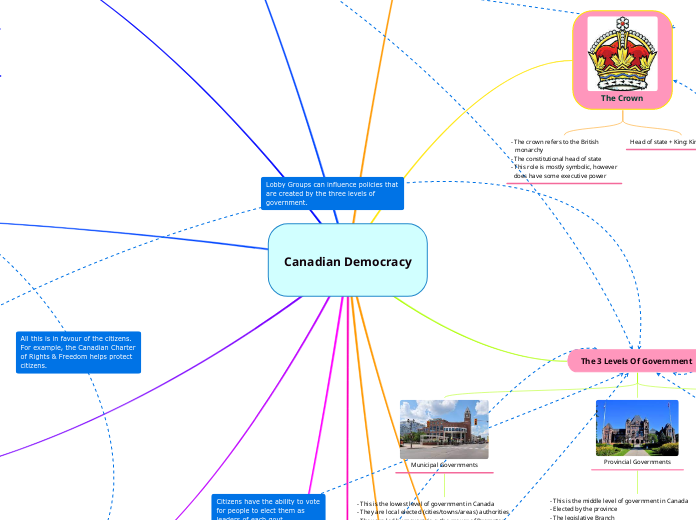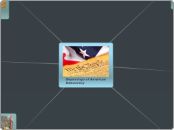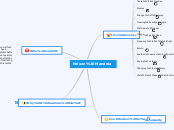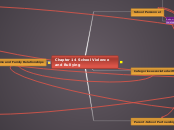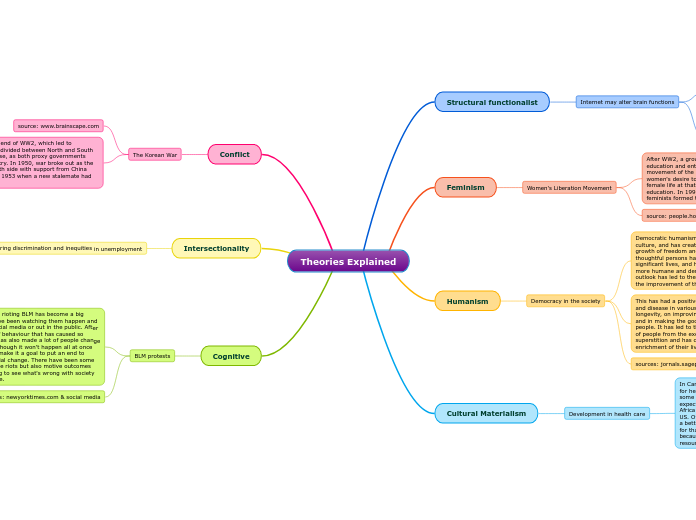Canadian Democracy
Free and Independent Press
Some of the main roles of the press include:
- Providing the public with accurate and current
information
- Can represent different voices and diversity
Free and Fair Elections
Citizens
A few of the many responsibilities of
citizens include:
Advocacy of issues.
Uphold human rights, and respect
all others around. Being a good
citizen overall.
Taking the responsibility to do their
part and protect the environment.
Fulfilling their civic duties, which
can include obeying laws,
paying taxes, and serving on
jury duty when called
Voting in federal, provincial, and
municipal elections.
- They are what shape the government
and society
Citizen Groups (Advocacy/Lobby Groups)
Characteristics of Lobby groups:
Public awareness
Influencing the development and
implementation of polciices
Advocacy + Representation
Such groups are extremely important when
it comes to advocating for specific causes,
influencing public opinion, and shaping
public policies
They are organizations formed by people
that have common goals and interests
Main Canadian Constitution
including the Charter Of Rights
& Freedom
Canadian Charter of Rights & Freedom
Covers multiple areas, including fundamental
freedoms, democratic rights, legal rights,
equality rights, and language rights. Examples
below:
asembly
religion
freedom of expression
A constitutional document that guarantees
fundamental rights and freedoms to all
individuals in Canada
The Main Canadian Constitution is made up of
multiple constitution acts, while also
including the charter of rights and freedom
British North America Act
The BNA Act defined the role
of the monarch as the head of state
Established a federal system of government
Divided powers between the federal government
and provinces
Outlined the specific areas of jurisdiction for each
level of government
The act brought together the provinces of Ontario
(then known as Canada West), Quebec (then known
as Canada East), New Brunswick, and Nova Scotia
into a federation (Dominion of Canada)
It was enacted in 1867
Played a significant role in the establishment
of Canada as a federal Dominion
Treaties with Indigenous People
Peace & Friendship treaties
They were agreements between the
British Crown and various Indigenous
nations, including the Mi'kmaq, Maliseet,
and others. The Peace and Friendship
Treaties recognized Indigenous rights to land,
resources, and self-government, while also
establishing peaceful relations and facilitating
trade.
Numbered Treaties
Numbers from treaties 1 through 11.
They cover a large portion of what
Canada is in the present day.
A treaty is a formal and legal binding/agreement
between two or more parties. They are negotiated
and signed by party representatives.
The Judicial Branch
Supreme Court of Canada
Federal Court of Appeal
Tax Courts of Canada
Federal Court
Federal Administrative
Tribunals
Provincial/Territorial Courts
of Appeal
Provincial/Territorial
Superior Courts
Provincial/Territorial
Administrative Tribunals
Provincial/Territorial
Courts
Court Martial Court Appeal
Military Courts
- In simple terms, this branch is a
system of courts
- These courts are known for settling
legal disputes/disagreements
Indigenous Governments
A few of more known Indigenous
governments in Canada at the moment
are:
- Assembly of First Nations (AFN)
- Inuit Tapiriit Kanatami (ITK)
- Métis National Council (MNC)
- Gives Indigenous communities the control
of administration of their people, land,
resources and related programs
- Band COuncils
The 3 Levels Of Government
Federal Government
- This is the highest level of government in Canada
- Elected by the country
- It is the executive branch
- The federal government is led by the Prime Minister
(At the moment, it is Justin Trudeau, a part of the
Liberal party)
- MPs (members of the parliament) are also a part of
this level of government
- Similar to the way premiers get elected, the Prime
Minister is elected based upon the highest number
of MPs elected in from a political party
- There are 333 MPs at the moment
- MPs debate and pass laws in the House of Commons,
which is located in Ottawa (picture above)
- The crown gets represented by the governor general
- The federal government has countless responsibilities,
which include immigration, defence, trade, and countless others
Provincial Governments
- This is the middle level of government in Canada
- Elected by the province
- The legislative Branch
- A provincial government is led by the premier (the
Ontario's premier at the moment is Doug Ford who is
a part of the PC party)
- Other than that, MPPs (members of the provincial parliament are also involved)
- Premiers are elected through the highest number of MPPs winning from a party
- There are 124 MPPs at the moment
- The lieutenant general is the representative of The Crown
- Provincial governments are responsible for things such as education, health care, the environment, agriculture, highways, etc.
- In terms of Ontario, all involved debate and pass laws in the legislative assembly in Toronto
Municipal Governments
- This is the lowest level of government in Canada
- They are local elected (cities/towns/areas) authorities
- They are led by mayors (e.g. the mayor of Brampton
is Patrick Brown, from the Conservative party)
- Municipal governments are responsible for providing services that are best managed under local control (e.g. public transit, waste disposal, fire services, police, community centres, libraries, property taxes etc.)
- Chief Administrative Officer (CAO): The most senior official in the City's administrative structure (in the City of Brampton, it is Marlon Kallideen
- There are also city councillors involved in this govt.
- Members of a municipal government usually meet in the city hall (an image for the one in Brampton is attached above)
The Crown
Head of state + King: King Charles III
- The crown refers to the British
monarchy
- The constitutional head of state
- This role is mostly symbolic, however
does have some executive power
The Main Political Parties In Canada
The Green Party
Is a progressive political
party.
New Democratic Party
The NDP leans more towards
the left side, and is also
considered to be more
conservative.
Bloc Quebecois
This is considered to be an
overall progressive political
party.
Conservatives
As the name suggests, they are
more conservative.
Liberals
They are more free-market
and progressive.
